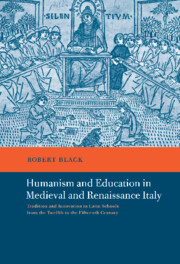 Humanism and Education in Medieval and Renaissance Italy
Humanism and Education in Medieval and Renaissance Italy Book contents
- Frontmatter
- Contents
- Acknowledgements
- List of abbreviations
- Editorial note regarding citations from manuscripts and publications
- A note on chronological terminology
- Introduction
- 1 Italian Renaissance education: an historiographical perspective
- 2 The elementary school curriculum in medieval and Renaissance Italy: traditional methods and developing texts
- 3 The secondary grammar curriculum
- 4 Latin authors in medieval and Renaissance Italian schools: the story of a canon
- 5 Reading Latin authors in medieval and Renaissance Italian schools
- 6 Rhetoric and style in the school grammar syllabus
- Conclusion
- Appendix I BL Harley 2653: the earliest known manuscript of Ianua
- APPENDIX II A handlist of manuscripts of Ianua
- Appendix III Manuscripts of Tebaldo's Regule
- Appendix IV Handlist of manuscripts of school authors produced in Italy and now found in Florentine libraries
- Appendix V Theoretical grammar manuscripts in Florentine libraries examined and included or eliminated as italian school grammars
- Appendix VI Authorities Cited Explicitly in Manuscripts of Major School Authors in Florentine Libraries
- Bibliography
- Index of manuscripts
- General index
6 - Rhetoric and style in the school grammar syllabus
Published online by Cambridge University Press: 25 July 2009
- Frontmatter
- Contents
- Acknowledgements
- List of abbreviations
- Editorial note regarding citations from manuscripts and publications
- A note on chronological terminology
- Introduction
- 1 Italian Renaissance education: an historiographical perspective
- 2 The elementary school curriculum in medieval and Renaissance Italy: traditional methods and developing texts
- 3 The secondary grammar curriculum
- 4 Latin authors in medieval and Renaissance Italian schools: the story of a canon
- 5 Reading Latin authors in medieval and Renaissance Italian schools
- 6 Rhetoric and style in the school grammar syllabus
- Conclusion
- Appendix I BL Harley 2653: the earliest known manuscript of Ianua
- APPENDIX II A handlist of manuscripts of Ianua
- Appendix III Manuscripts of Tebaldo's Regule
- Appendix IV Handlist of manuscripts of school authors produced in Italy and now found in Florentine libraries
- Appendix V Theoretical grammar manuscripts in Florentine libraries examined and included or eliminated as italian school grammars
- Appendix VI Authorities Cited Explicitly in Manuscripts of Major School Authors in Florentine Libraries
- Bibliography
- Index of manuscripts
- General index
Summary
THE SECONDARY SYLLABUS AS AN INTEGRATED CURRICULUM
In the three preceding chapters, an attempt has been made to analyse the secondary grammar curriculum in Italian schools during the middle ages and earlier Renaissance. The emphasis has been on identifying the constituent elements of the syllabus: formal grammar rules, vocabularies, composition exercises, mnemonic verses, synonyms/homonyms, orthographies, minor and major authors. It is well established that there was a progression from the auctores minores to the maiores, but otherwise it is not always evident in what order the rest of the curriculum was presented.
Fortunately, some insight into the manner and order in which the theoretical, practical and literary elements of the grammar syllabus were integrated in early fifteenth-century Florence is offered by a schoolbook now preserved as manuscript BNCF Landau Fin. 202. This paper codex, the work of a group of Florentine schoolboys, contains four texts (Statius's Achilleis (1r–15r), Cartula (16r–24r), Disticha Catonis (24v-31v) and the opening two books of Alexander of Villedieu's Doctrinale (32v-47v)), followed by a series of grammatical exercises (48r-118r, 138r-144r). The first thirteen folios were written by a young member of the Florentine lite, Antoniotto di Giovanni di Paolo Morelli (hand A), who left his note of possession on the inside back cover (I'): ‘Iste liber est mei Antoniotti Johannis Pauli de Morellis’.
- Type
- Chapter
- Information
- Humanism and Education in Medieval and Renaissance ItalyTradition and Innovation in Latin Schools from the Twelfth to the Fifteenth Century, pp. 331 - 365Publisher: Cambridge University PressPrint publication year: 2001
